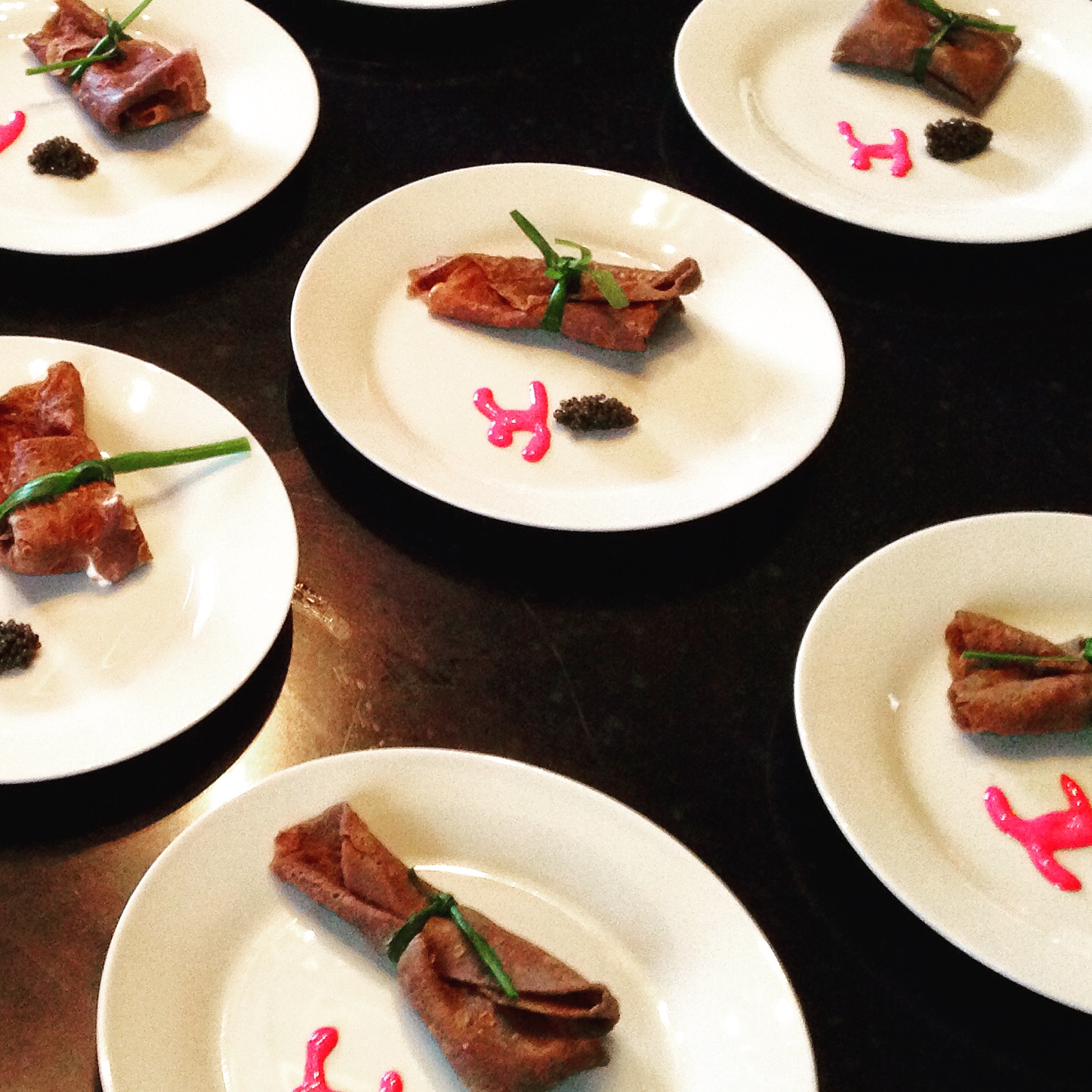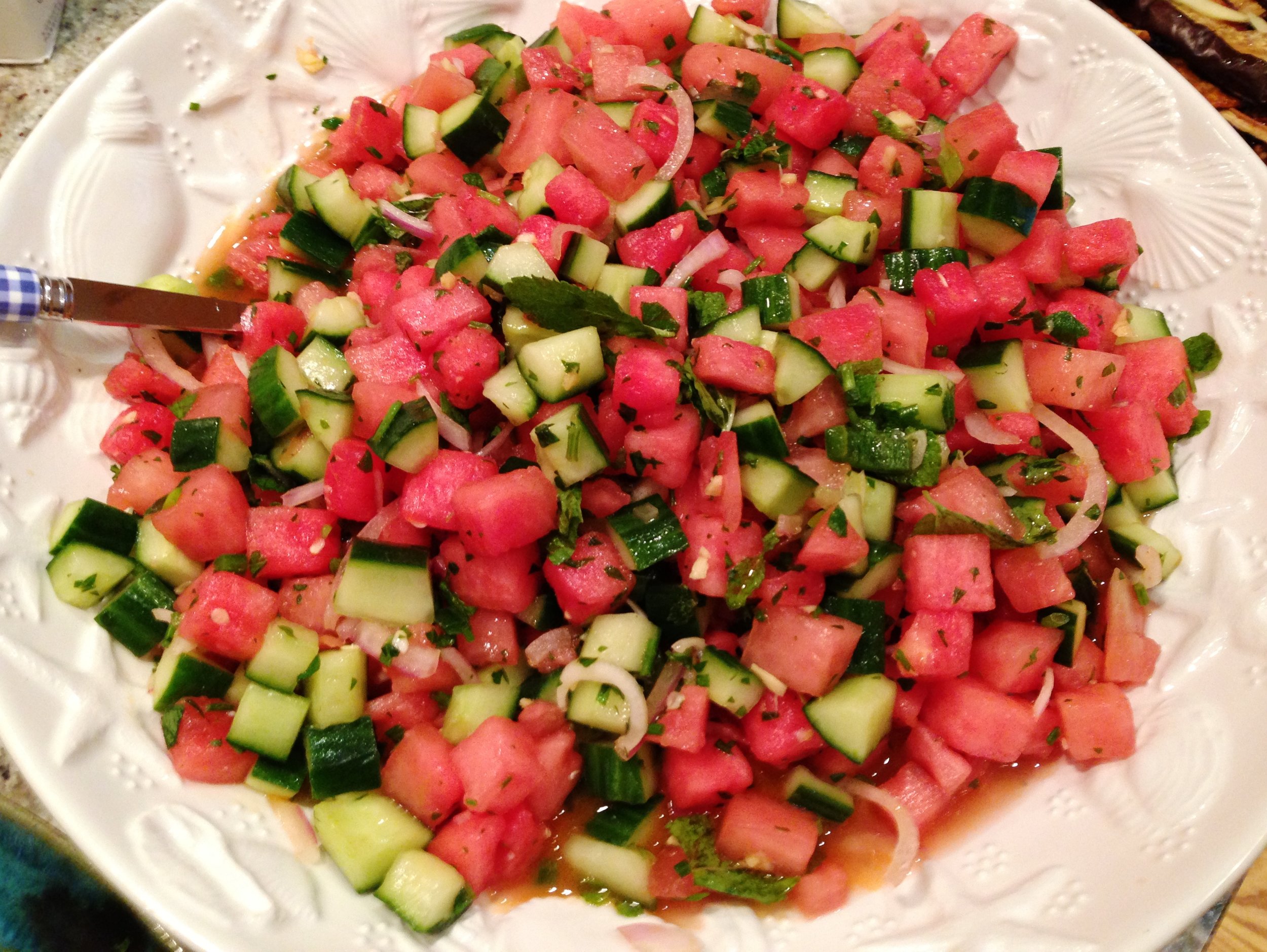ESCAPES: Santa Fe Eats
I wanted somewhere different -- at least from what I'm used to. I wanted to get away before my birthday, a brief respite so I could relax, get a little bit of my zen on, and of course, eat well. After a few weeks of internet searches and flight pricing, I realized I'd never been to New Mexico, that I'd always heard how amazing Santa Fe was as a small city, and that I have a dear friend in nearby Albuquerque. Why not?
Upon arrival, I quickly realized that I was not in New York City anymore. This landscape was so different, vast, its colors a pastel wash of sky, and earthen umber shades of mountain and desert. On the hour-long drive from the airport to Santa Fe, my friend Michelle and I started to catch up on each other's lives of late, and she briefed me on what to expect of Santa Fe. We arrived at our hotel, The Inn and Spa at Loretto, just before dusk on a Friday. We unpacked in our room and showered and changed for dinner: our first dilemma was where to eat during a busy weekend (there was a sold-out food festival in town, and things were hopping in Santa Fe at this time of year).
We chose a classic, Coyote Cafe, just down the street from our hotel. Chef Mark Miller was the original chef-owner who opened the restaurant back in 1987, and who made a name for gourmet Southwestern cuisine over the course of more than 30 years. He sold the place to his manager and a new chef in 2008 and the kitchen is turning out food as delicious as ever. Once we arrived, a snafu in the reservation system meant our drinks at the bar waiting for our table turned into dinner at the bar -- which we really didn't mind after all. We had lots to talk about over some delicious red wine (Michelle) and a spicy cocktail or two (me), and we enjoyed the bold, delicious flavor combinations like my grilled fiery hot and sweet tiger prawns, served on soft sesame polenta with baby bok choy and Maui pineapple salsa.
The next day we woke up and headed straight for brunch at the famous Cafe Pasqual's. There's usually a wait for a table here, and most definitely on weekends, but we were seated fairly quickly at the large central communal table. It's a social spot and the waiters and waitresses seem to know a majority of the clientele. Upon recommendation, we got egg dishes, including my delicious poached eggs on red chile with fresh corn.
I had been eyeing a lunch special on the menu that sounded so enticing, I'd eventually return during the week to get it: a half sandwich of turkey with thick cut bacon, lettuce, and tomato with a cup of avocado soup and a shredded kale salad. Perfect. After filling up on a great southwestern brunch, we were energized for exploring the town, shopping, and hitting the Georgia O'Keefe Museum, which, as a fan of her art, I've been wanting to visit for many years. It's small but full of some of her most famous pieces, and the short film on her life, narrated by Santa Fe resident Gene Hackman, is informative and beautiful.
And the gift shop is fab! We did some window shopping and some actual shopping around town afterwards, and I struggled to not purchase every gorgeous piece of turquoise jewelry we saw. I knew I'd treat myself to something, but I wanted to "do the rounds" first and see everything I could. I was here for another few days, after all, so I could take my time and scan the stores for the best offerings.
We did, however, make a happy impulse purchase at Chocolate Smith. At this small outpost inside one of the malls lining the main plaza in town, glorious iterations of chocolate with a southwestern kick are on display, and it's really pointless to avoid the temptation. I bought plenty of chocolates and truffles and the usual dark chocolate suspects...but I also purchased plenty of the unique assortment of chocolate barks they create. This includes a very New Mexican dark chocolate-green chile-pistachio bark, and "Mountain Bark" -- a mixed bag of chocolate bark with marinated cherries, coconut, homemade English toffee, white chocolate bits and toasted almonds. They managed to combine everything good in one bark!
We returned to the hotel late afternoon, in time for me to book a relaxing facial at the spa downstairs, which was luxurious and complete with aromatherapeutic oils. We'd booked dinner at the charming Santacafe, a petite dining spot that's a favorite among locals for continental fare using regional ingredients with a Santa Fe twist (which seems to go without saying here).
A delicious seasonal salad, of arugula, grilled peaches, candied spiced pecans, and crispy fried goat cheese was a great opener, alongside a spicy jalapeno-lime vodka cocktail. A main course of a perfectly-cooked beef fillet with a red wine sauce, haricot vert, and shoestring fries, was a great high-low balance on one plate -- and hit the spot. Drinks after dinner were in order, though places in Santa Fe close much earlier than expected (and certainly wayyy earlier than we were used to in our days hanging out in Manhattan until the wee hours!) -- midnight seemed to be the cut-off point for a majority of spots. But the drinks were delicious, the setting beautiful, and the crowd fun and just rowdy enough at Secreto Lounge at the Hotel St. Francis. It was better that we hit the hay early, anyway.
Sunday morning in Santa Fe was sunny and mild, and we made a beeline to an old breakfast favorite on the plaza, Plaza Cafe. I'd categorize this as a diner-plus, with a large menu that includes all of the diner staples, but really focuses on -- what else? -- Southwestern favorites like breakfast burritos and enchiladas. I decided to go for "Christmas," as it's called in these parts: both green and red chile sauces with my breakfast enchiladas. This also included a warm container of homemade flour tortillas, guac and sour cream, beans, and a side of bacon. I ordered a homemade cactus pear lemonade, a first for me, and out came a gorgeous tall glass of fuchsia-colored citrus deliciousness! What a great way to start our day.
We wandered along the plaza again, and things started to get a little strange. We'd spotted a few random celebrities in restaurants and outside over the weekend, TV actors and the like. But as we were strolling along the plaza looking at local Native American-made jewelry, my friend and I, both tall women, almost literally ran over...Dr. Ruth Westheimer. She was so small, and just as we were trying not to crush her, one of the jewelry makers asked for a photo with her. As this was happening, a thin woman with short salt-and-pepper hair ran up to Dr. Ruth, who was beside us at this point, and screamed "Dr. Ruth!" It was Jamie Lee Curtis. They embraced and my friend and I, wondering what was going on this weekend with the celebrities, asked Dr Ruth, who said there was a health conference in town, and lots of celebrities were in attendance. So there was that. We continued on our way, and I was making mental notes of all of the gorgeous turquoise jewelry I wanted to buy before leaving town.
Sadly, my friend Michelle had to head back to Albuquerque for the start of the work week. And I switched hotels and checked into the swank La Posada Resort and Spa. I had my own little adobe-hut on the property, with a wood burning fireplace and other cozy essentials. What I no longer had was a dining partner, but I was determined to make my solo dining experience an adventure. All I needed was my palate, my camera, and a good book -- I was prepared!
The first night, I decided to head to The Inn at Anasazi's Restaurant, on the ground floor of a cozy Rosewood Resort with a Native American, log cabin-in-the-woods feel (albeit a luxurious log cabin). The staff, to a person, was accommodating and kind, the best sort of place for a solo dining experience. I enjoyed a delicious tamale appetizer with a mole sauce to start off.
The main event was a roasted salmon fillet, done in true southwestern style with a spicy, smoky glaze and served with asparagus, artichokes, and mushrooms. This was accompanied by some delicious pinot noir, and of course my book. But the servers also chatted me up, and upon discovering I was a chef, decided to treat "their own" to a little extra special service, as restaurant industry people are known to do. They sent the chef out to say hello to me, gave me some excellent food and tourist recos for Santa Fe, and just generally made me feel special and welcome.
Dessert was, for me, an obligatory chocolate experience: mousse, ice cream, dark chocolate cookie crumbles and white chocolate and caramel sauces. I left feeling pleasantly full, happy, and taken care of -- exactly what anyone really looks for in a restaurant experience.
The next afternoon, I enjoyed a light lunch at La Casa Sena, a gorgeous outdoor spot in an interior courtyard plaza off the main square. Delicious blue corn muffins with sweet butter and a southwestern grilled chicken salad hit the spot, and it was perfect weather to lounge al fresco and read in the shade. Later that day, I enjoyed some spa treatments back at La Posada's spa. I was even able to sneak in some lounging at the pool in the afternoon sun. And of course I circled back and checked out some more jewelry shops for some of that gorgeous turquoise sold all over town.
For dinner that night? Geronimo, a well-regarded fine dining establishment on the gallery-lined Canyon Road. This time, I got a few looks from couples out on romantic dinner dates, but I didn't care. I was there to enjoy beautifully-presented dishes like the sushi grade tuna appetizer, served seared and tartare with little buckwheat blini, wasabi, teriyaki, and spicy pepper sauces.
My main course was a house specialty, and falls under the "when in Rome" menu choice category: peppery elk tenderloin with applewood smoked bacon, fork-smashed potatoes, sugar snap peas, and a brandied mushroom sauce. The dish was, I admit, decadent and damned delicious.
I splurged and went for dessert, but kept it to a minimal plate of "mignardises": fruit squares, toffee, truffles, macarons, and brittle. It was a delicate and perfect finish to a rich, languid meal in posh surroundings. It really put me in the mood to go back to the hotel, make a fire in my fireplace, and write. And then, to crawl under the covers with a good book, as the embers of the fire smoldered. Southwestern solitude: perfection.
The next day was my last in Santa Fe before heading back to Albuquerque, so I was intent on enjoying it. I woke up at La Posada and decided to indulge in breakfast in bed -- or at least in my adobe. New Mexicans do not mess around with breakfast: I ordered a breakfast burrito with red chile sauce, and it came with beans and potatoes on the side, topped with cheese and lettuce and sour cream for the full burrito experience.
Of course, this was a full on meal that provided me energy for the entire day, so I was good to go tooling around town. It also took a while to digest, so I was *forced* to sit by the pool and catch up on reading some of my favorite magazines in the sun. No complaints.
And I finally decided on the store that had the best selection of turquoise jewelry for me to choose from and purchase (it was a birthday gift to myself). I was sad to learn about so many different varieties of American turquoise that are no longer found in these parts -- many of the pieces used stones that had last been mined in the '60s and '70s. But they were gorgeous, and I went home happy with turquoise of various colors and personalities. I did indulge in a late afternoon snack -- the breakfast burrito effect had started to wear off! -- so I tried a bowl of local New Mexico chili, made with pork and served with a little shredded cheese and some tortilla chips (okay, and a side of queso fundido I may have ordered).
I sat on the upstairs balcony of Thunderbird Bar and Grill on the Plaza, and just people-watched as locals and visitors strolled through the square, and tourists sipped oversized margaritas in the bar around me. It was a little cheesy, but I didn't want to leave Santa Fe without having had the chili experience. It was tasty and hit the spot as the sun set and the high-altitude air cooled, easing into evening. I walked the gorgeous streets of Santa Fe one last time, until I made my way back to La Posada.
The resort's grounds are so beautiful that a leisurely walk around them is a simple pleasure. And, since the next day would be a very early morning, heading back to ABQ, drinks at the hotel bar and a light dinner was just the ticket. It was my first adventure in Santa Fe, but I vowed it would not be my last. And with this thought, I toasted my trip to New Mexico with a glass of its finest sparkling wine. Yes, you read that correctly. And the bubbly? It's delicious.
The Inn and Spa at Loretto
211 Old Santa Fe Trail
(800) 727.5531
www.innatloretto.com
La Posada de Santa Fe Resort + Spa
330 East Palace Avenue
(505) 986.0000
www.laposadadesantafe.com
Coyote Cafe
132 West Water Street
(505) 983.1615
www.coyotecafe.com
Cafe Pasqual's
121 Don Gaspar Avenue
(505) 983.9340
www.pasquals.com
Santacafe
231 Washington Avenue
(505) 984.1788
Chocolate Smith
851A Cerrillos Road
(505) 473-2111
www.chocolatesmith.com
Anasazi Restaurant at Rosewood's The Inn at Anasazi
113 Washington Avenue
(505) 988.3030
www.rosewoodhotels.com/en/inn-of-the-anasazi-santa-fe/dining/anasazi-restaurant
Geronimo
724 Canyon Road
(505) 982.1500
www.geronimorestaurant.com
La Casa Sena
125 East Palace Avenue
(505) 988.9232
www.lacasasena.com
Luminaria Restaurant + Patio
The Inn at Loretto
211 Old Santa Fe Trail
(505) 984.7915
Plaza Cafe
54 Lincoln Avenue
(505) 982.1664
www.plazacafesouth.com
Secreto Lounge in the Hotel St. Francis
210 Don Gaspar Avenue
(505) 983.5700
Thunderbird Bar and Grill on the Plaza
50 Lincoln Avenue
(505) 490.6550
www.thunderbirdsantafe.com






























































































































































































